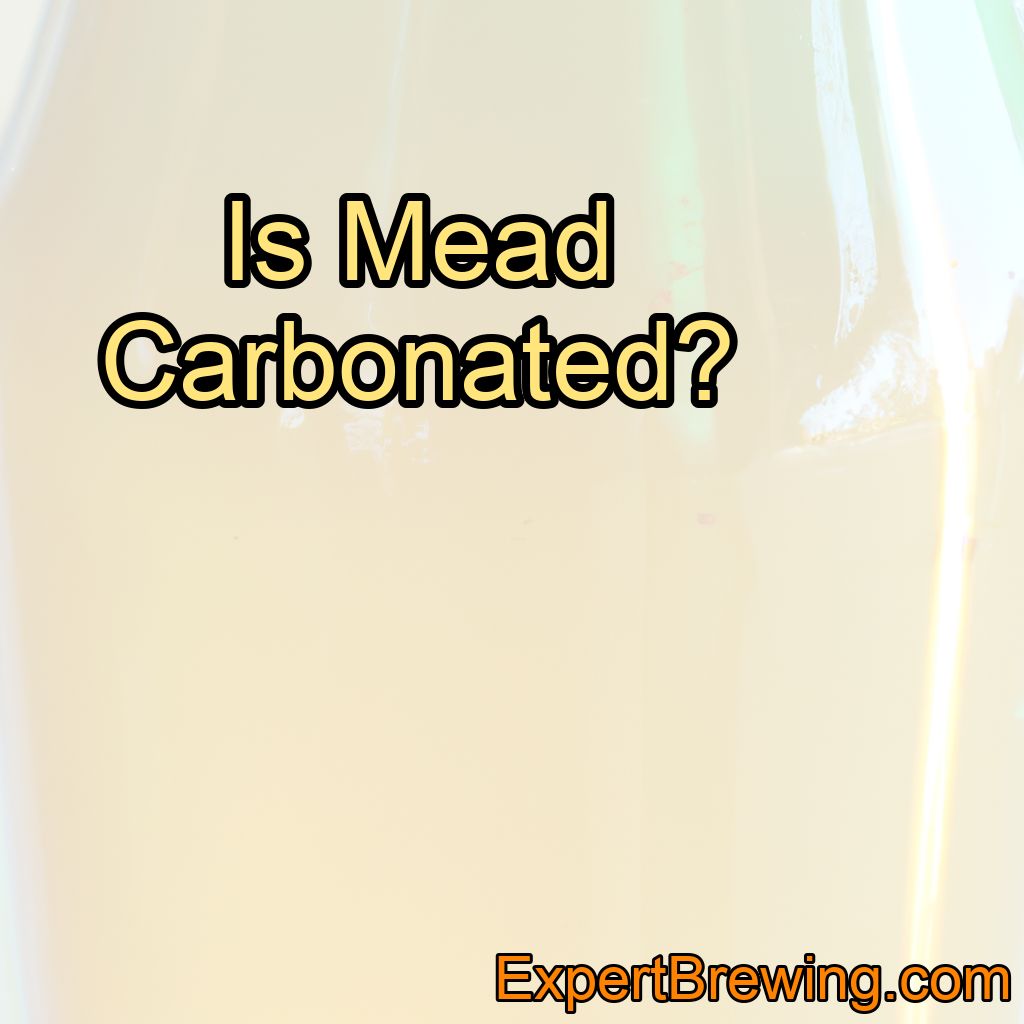Is mead carbonated? The short answer is: it can be, but it doesn’t have to be.
Mead, the ancient alcoholic beverage made from fermented honey, water, and sometimes additional flavorings, can be enjoyed in a variety of forms.
These including still (non-carbonated), lightly carbonated, or sparkling (highly carbonated).
In this blog post, I will share my personal experience and knowledge on the topic of carbonation in mead, and dive into the various types of mead, carbonation methods, and factors that affect carbonation levels.
A Brief History of Mead
Mead is one of the oldest known alcoholic beverages, with evidence of its production dating back thousands of years. Ancient civilizations in Europe, Africa, and Asia all enjoyed mead in various forms, often attributing mystical or medicinal properties to it.

Over time, mead has evolved and diversified into a wide range of styles, from sweet to dry, still to sparkling, and flavored with fruits, spices, and other ingredients. As a passionate homebrewer and mead maker, I have had the pleasure of experimenting with and enjoying many of these styles myself.
Traditional Mead
Traditional mead is made using only honey, water, and yeast, and can range from sweet to dry, depending on the amount of honey used and the fermentation process.

In its simplest form, traditional mead is not carbonated, as the fermentation process consumes the sugars present in the honey and produces alcohol and carbon dioxide, which is allowed to escape during fermentation.
However, traditional mead can also be carbonated, either through natural fermentation or forced carbonation, which I will discuss later in this post.
Types of Mead and Carbonation Levels
As I mentioned earlier, mead can be enjoyed in various forms and carbonation levels, depending on personal preferences and the specific style of mead. Here are some common types of mead and their typical carbonation levels:
Still Mead
Still mead is a non-carbonated mead, similar to a wine, with no noticeable bubbles or effervescence. This is the most common form of mead, as it is the easiest to produce and requires no additional steps or equipment for carbonation. Still mead can be enjoyed at room temperature or slightly chilled, and is often sipped slowly to savor the rich honey flavors and alcohol warmth.
Petillant Mead
Petillant mead is a lightly carbonated mead, with a subtle effervescence that can enhance the overall drinking experience. This type of mead can be achieved through natural fermentation in the bottle, or by using forced carbonation methods.

Petillant mead is often served chilled, and its light carbonation can make it more refreshing and enjoyable, particularly in warm weather or as an aperitif.
Sparkling Mead
Sparkling mead is a highly carbonated mead, similar in effervescence to champagne or sparkling wine. This type of mead can be produced using the traditional méthode champenoise, where secondary fermentation occurs in the bottle, or by using forced carbonation methods.

Sparkling mead is typically served chilled in champagne flutes, and its lively bubbles and bright flavors make it a festive and celebratory choice for special occasions.
Methods of Carbonating Mead
There are several methods to achieve carbonation in mead, each with its own advantages and challenges. In this section, I will discuss the most common methods I’ve used in my own mead-making journey.
Bottle Conditioning
Bottle conditioning is a natural method of carbonating mead, where the mead undergoes a secondary fermentation in the bottle. This is achieved by adding a small amount of additional fermentable sugar (usually honey) to the mead before bottling, and allowing the residual yeast to consume the sugar and produce carbon dioxide. The carbon dioxide becomes trapped in the sealed bottle, resulting in carbonation.
Kegging and Forced Carbonation
Kegging and forced carbonation is a method commonly used by homebrewers and commercial mead makers to achieve precise and consistent carbonation levels. This involves transferring the mead into a keg or other pressure-rated vessel, and then injecting carbon dioxide gas into the mead under pressure.
The carbon dioxide dissolves into the mead, creating carbonation. The advantage of this method is that it allows for greater control over the carbonation level and eliminates the risk of bottle bombs, which can occur with bottle conditioning if too much sugar is added.
Using a SodaStream!
Yep, I’ve done it and it works. You can carbonate your mead using a SodaStream or similar sparkling water making device!
You can read how it is done and what to be aware of in my article using cider as an example:

A sodastream is basically a kegging device, but there are smarter and cheaper options out there for home brewing.
Using a carbon dioxide canister and screw lid:
This is a popular, less expensive, method among home brewers for small batches of mead.
All you need is a screw-top lid and a small carbon dioxide canister and a tube with adapters that connects them!
You can buy the screw cap that fits on any standard soda bottle with a tight seal, so you can basically carbonate your mead (or, cider, wine, juice, beer etc.) directly in the bottle you want to store it in as well.
The other end of the tubing fits a standard carbon dioxide canister, which is probably the most expensive part, but quite a lot cheaper than those for the SodaStream machine if you consider the volume.
The process is quite simple:
1. Cool your cider in a soda bottle overnight in the fridge. Fill it to maximally 80% full capacity.
2. Screw on the connector screw cap to your soda bottle and the other end to your CO2 canister.
3. Open the valve on the carbon dioxide canister and let it hiss until you have carbonated your cider to your desired level.
In contrast to the SodaStream, this setup actually allows you to control the speed of carbonation as you can open the valve to achieve any desired flow rate.
Factors Affecting Carbonation in Mead
There are several factors that can affect the carbonation level in mead, including yeast selection, fermentation temperature, and the amount of fermentable sugar present. As a mead maker, it’s important to understand these factors and how they can impact the final product.
Yeast Selection
Different strains of yeast have different abilities to withstand alcohol and carbon dioxide pressure, which can impact the final carbonation level in mead. Some strains of yeast are more suitable for sparkling mead production, while others may struggle to produce enough carbon dioxide to create noticeable carbonation. When selecting a yeast strain for mead, it’s important to consider the desired carbonation level and choose a strain that can achieve that outcome.
Fermentation Temperature
The temperature at which mead ferments can also impact the carbonation level, as higher temperatures can cause yeast to produce more carbon dioxide. However, higher fermentation temperatures can also produce off-flavors and other undesirable characteristics in the mead, so it’s important to find a balance between temperature and carbonation.
Fermentable Sugar Content
The amount of fermentable sugar present in the mead will directly impact the amount of carbon dioxide produced during fermentation. If there is not enough sugar for the yeast to consume, the mead will not carbonate as desired. Conversely, if too much sugar is added, it can result in over-carbonation or bottle bombs in the case of bottle conditioning. Careful measurement and calculation of the sugar content is crucial for achieving the desired carbonation level.
Conclusion
Mead can be enjoyed in a variety of forms and carbonation levels, from still to sparkling, making it a versatile and diverse beverage to explore and enjoy. Whether you prefer the rich, still flavors of a traditional mead, or the lively effervescence of a sparkling mead, there is a mead style and carbonation level to suit every palate.
Here are some key facts about mead carbonation:
1. Mead can be still, petillant, or sparkling, depending on the desired carbonation level.
2. Traditional mead is made from honey, water, and yeast, and can be carbonated or non-carbonated.
3. Still mead is a non-carbonated mead, similar to wine.
4. Petillant mead is a lightly carbonated mead, achieved through natural fermentation or forced carbonation.
5. Sparkling mead is a highly carbonated mead, similar to champagne.
6. Bottle conditioning is a natural method of carbonating mead through secondary fermentation in the bottle.
7. Kegging and forced carbonation is a method used to achieve precise and consistent carbonation levels.
8. Yeast selection, fermentation temperature, and fermentable sugar content are factors that affect carbonation in mead.
9. Different types of mead and carbonation levels can suit different occasions and personal preferences.
10. Experimenting with mead styles and carbonation levels can be a fun and rewarding aspect of mead-making and enjoyment.
FAQs
What is a carbonated mead called?
A carbonated mead is commonly referred to as a “sparkling mead.”
Are there different types of mead?
Yes, there are different types of mead. Mead can vary in flavor, sweetness, and strength depending on the ingredients used and the fermentation process. Some common types include traditional mead (made primarily from honey), melomel (made with added fruits), metheglin (made with added spices or herbs), and braggot (made with added malt). Each type offers unique characteristics and taste profiles.
Why is my homemade mead carbonated?
Homemade mead can become carbonated due to residual yeast activity during fermentation. If there is still fermentable sugar present when the mead is bottled, the yeast can continue consuming the sugar and producing carbon dioxide. This carbon dioxide gets trapped in the sealed bottle, resulting in carbonation. To prevent carbonation, ensure that fermentation is complete before bottling by checking specific gravity readings and allowing the mead to stabilize.
Why does my mead taste carbonated?
Mead can taste carbonated due to the presence of carbon dioxide (CO2) in the beverage. This can occur if fermentation is not complete before bottling, resulting in residual sugars being converted into CO2 during the aging process. Additionally, if the mead is not properly degassed or if secondary fermentation occurs in the bottle, it can lead to a carbonated taste.
Why does no one drink mead anymore?
Mead, a fermented honey beverage, has seen a decline in popularity over the centuries due to various factors. The rise of beer and wine production, changes in taste preferences, and the availability of other alcoholic beverages have contributed to mead’s decline. Additionally, the labor-intensive nature of mead production and the cost of honey as a primary ingredient have made it less commercially viable compared to other options. However, in recent years, mead has experienced a resurgence, with craft meaderies and a growing interest in historical and unique beverages.
Does mead get carbonated?
Yes, mead can be carbonated. Carbonation in mead can be achieved through a process called secondary fermentation, where additional sugars or honey are added to the mead before bottling. This provides the yeast with more food to ferment, resulting in the production of carbon dioxide, which creates the carbonation.





